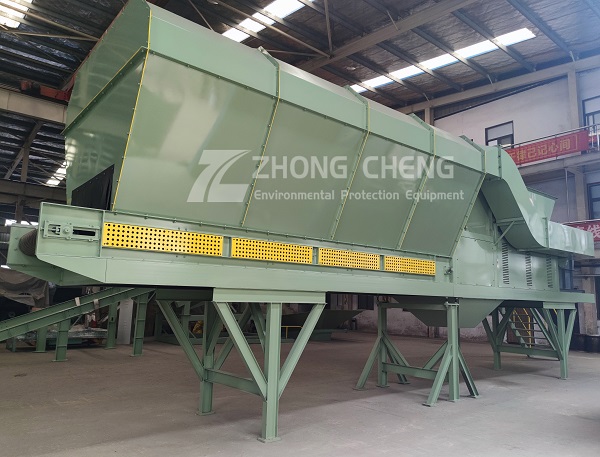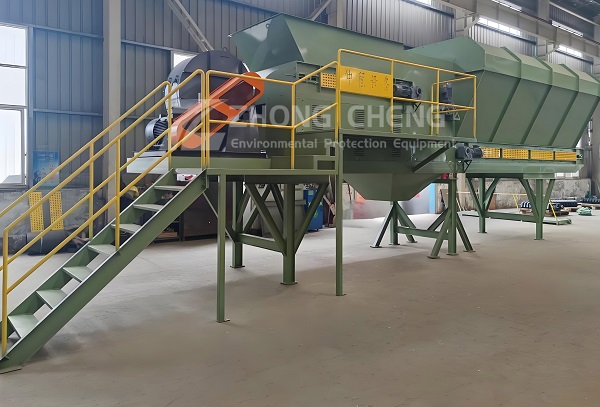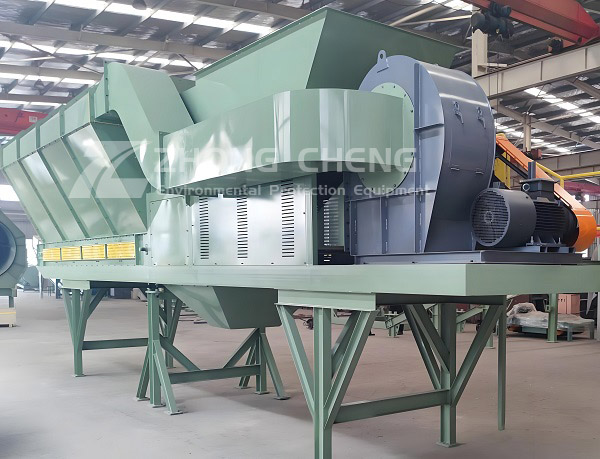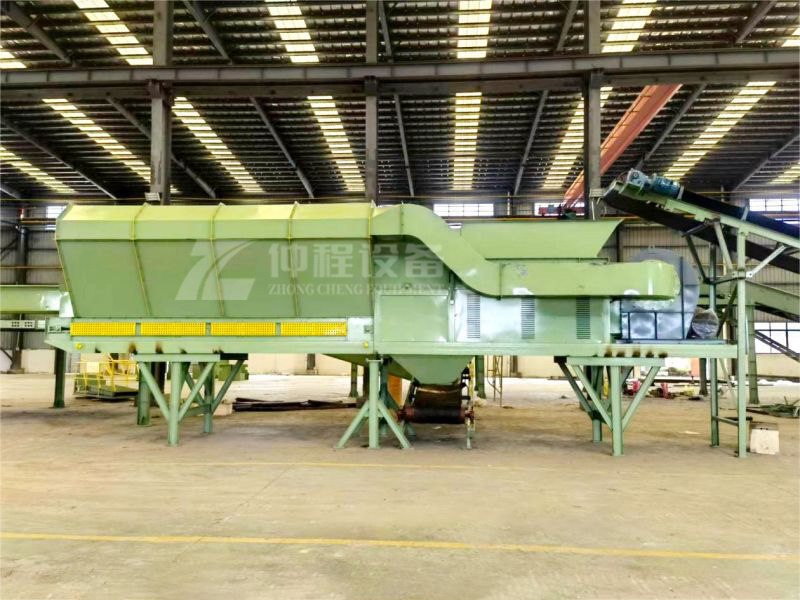In the field of modern waste treatment and material sorting, the air separator, as a key equipment for material separation using aerodynamic principles, plays an indispensable role with its high efficiency, environmental protection, and wide range of applications. From the separation of lightweight plastics and paper in urban domestic waste, to the screening of materials of different densities in industrial waste, to the sorting of seeds and impurities in the agricultural field, the air separator has shown strong application value. However, there are many types of air separators on the market with different performances. How to choose a high-quality air separator that meets actual needs has become an important issue faced by many users. This article will elaborate on the working principle, core purchase factors, precautions, etc. of the air separator, and provide users with a comprehensive purchase guide.
Core purchase factors of air separator

Air Separator
1. Matching processing capacity with production scale
Material processing volume: Users need to determine the processing capacity of the air separator according to their own production scale and material processing needs. For example, large-scale waste treatment plants need to process hundreds of tons of domestic waste every day, so they need to choose air separators with large processing capacity; while small enterprises or laboratories have a small processing volume and can choose equipment with relatively low processing capacity. Generally speaking, the processing capacity of the air separator is measured by the weight (tons/hour) or volume (cubic meters/hour) of the material processed per hour. When purchasing, you should ensure that the processing capacity of the equipment is slightly greater than the actual demand to cope with possible production peaks.
Continuous working time: It is also important to consider the continuous working capacity of the air separator. For production scenarios that require long-term uninterrupted operation, such as large industrial production lines, air separators with good heat dissipation performance, strong mechanical structure and long-term stable operation should be selected to avoid production interruptions due to equipment failure.
2. Adaptation of sorting accuracy and material characteristics
Material properties: Different materials have different densities, shapes, sizes and surface characteristics, all of which will affect the sorting effect of the air separator. For example, for materials with large density differences, ordinary air separators may be able to achieve better sorting effects; for materials with similar densities but different shapes and sizes, it is necessary to select air separators with special designs or adjustment functions. When dealing with domestic waste, since the light materials such as plastics and paper have irregular shapes and the density difference with heavier materials is not particularly large, it is necessary to choose a wind separator that can flexibly adjust the airflow parameters and has a reasonable sorting area structure to improve the sorting accuracy.
Sorting requirements: Clarifying the required sorting accuracy is the key to purchasing a wind separator. If the purity of the sorted materials is required to be high, such as in industrial material recycling, if you want to separate different types of plastics as completely as possible, you need to choose a wind separator with high sorting accuracy. This type of wind separator usually has a more accurate airflow control system, a more reasonable sorting structure design, and a more complete adjustment function. It can achieve accurate sorting of materials by adjusting parameters such as airflow speed, wind direction, and the size of the sorting area.

Air Separator
3. Equipment material and durability considerations
Main structure material: The main structure material of the wind separator directly affects the service life and stability of the equipment. Generally speaking, high-quality steel or stainless steel has the advantages of high strength, corrosion resistance, and non-deformation, and can adapt to various harsh working environments. For example, when dealing with industrial waste containing corrosive substances, the use of stainless steel air separators can effectively prevent the equipment from being corroded and extend the service life of the equipment. In addition, key components of the equipment, such as fan impellers, sorting chambers, etc., should also be made of reliable quality materials to ensure that they will not be damaged during high-speed operation and long-term use.
Wear resistance: During the operation of the air separator, friction will occur between the material and the internal components of the equipment, especially for some hard or angular materials, which are easy to cause wear to the equipment. Therefore, the easily worn parts of the equipment, such as the feed inlet and the inner wall of the sorting chamber, should be made of wear-resistant materials or wear-resistant treatment, such as adding wear-resistant linings and spraying wear-resistant coatings. This can reduce the degree of wear of the equipment, reduce maintenance costs, and improve the operating efficiency of the equipment.
4. Energy consumption and operating cost analysis
Power and energy consumption: The power size of the air separator is directly related to its energy consumption level. When purchasing, the power parameters of air separators of different brands and models should be compared, and equipment with high energy efficiency ratio should be selected. Generally speaking, advanced fan design, reasonable air flow channel layout and efficient transmission system can help reduce the energy consumption of equipment. For example, fans using variable frequency speed regulation technology can automatically adjust the fan speed according to the actual material handling capacity and sorting requirements, thereby reducing energy consumption while ensuring the sorting effect.
Maintenance cost: In addition to energy consumption costs, equipment maintenance costs are also an important part of operating costs. Choosing a wind separator with a simple structure that is easy to disassemble and assemble is convenient for daily cleaning, maintenance and repair, which can reduce downtime and repair costs. At the same time, it is also critical to understand the price and supply of equipment wearing parts to avoid affecting the normal operation of the equipment due to excessively high prices or untimely supply of wearing parts.

Air Separator
5. Automation and convenience of operation
Automation function: With the continuous development of science and technology, more and more wind separators are equipped with automatic control systems. These systems can realize functions such as automatic start and stop of equipment, automatic adjustment of air flow parameters, and automatic fault alarm, which greatly improves the operation convenience and operation stability of the equipment. For example, some high-end air separators can monitor the properties and sorting effects of materials in real time through sensors, and automatically adjust the airflow speed and wind direction to achieve the best sorting state, reducing manual intervention and improving production efficiency.
Human-machine interaction interface: The friendly human-machine interaction interface allows operators to control the equipment more intuitively and conveniently. When purchasing, you should choose an air separator with a clear and easy-to-understand operation interface. The various parameter displays and operation buttons on the interface should be reasonably laid out to facilitate operators to quickly master the operation methods of the equipment. In addition, some air separators are also equipped with remote monitoring and control functions, which can realize remote operation and fault diagnosis of the equipment through the network, further improving the management efficiency of the equipment.
Precautions for purchasing air separators
1. Field investigation and case reference
Before purchasing an air separator, it is recommended that users conduct field investigations on the equipment manufacturer and the site of use. By visiting the manufacturer, you can understand the manufacturer's production scale, technical strength, quality control system, etc., and judge the manufacturer's reliability and product quality. At the same time, by inspecting the actual use site of the equipment, you can intuitively see the operation of the air separator, the sorting effect, and the problems of the equipment in actual application, listen to the feedback from the users, and provide a more real and reliable reference for purchase. In addition, you can also refer to the successful cases provided by the manufacturer to understand the application effect of the air separator in different industries and different working conditions, and evaluate whether the equipment is suitable for your needs.

Air Separator
2. After-sales service and technical support
Good after-sales service and technical support are important factors that cannot be ignored when purchasing an air separator. In the process of equipment use, various faults and problems are inevitable. Timely and professional after-sales service can ensure that the equipment resumes normal operation as soon as possible and reduce production losses. Therefore, you should choose a manufacturer with a complete after-sales service system and a fast response speed, and understand whether the manufacturer provides equipment installation and commissioning, personnel training, regular maintenance and other services, and whether there is a professional technical team that can solve technical problems that arise during the operation of the equipment in a timely manner. In addition, you should also pay attention to the manufacturer's warranty period and warranty content for the equipment to ensure that the equipment can be repaired or replaced in time when quality problems occur during the warranty period.
3. Compliance and environmental protection requirements
Industry standards and certifications: The selected air separator should comply with national and industry-related standards and specifications, such as mechanical safety standards, electrical safety standards, etc. At the same time, check whether the equipment has passed relevant quality certifications, such as ISO quality management system certification, CE certification, etc. These certifications are a recognition of the quality and safety of the equipment and can be used as an important reference for purchase.
Environmental performance: With increasingly stringent environmental protection requirements, the environmental performance of air separators has also attracted much attention. The emission of pollutants such as dust and noise should be minimized during operation. Choosing an air separator equipped with high-efficiency dust removal devices and noise reduction measures can effectively reduce the impact on the working environment and the surrounding environment. For example, the use of bag dust removal or cyclone dust removal can effectively collect and treat the dust generated during the operation of the equipment; by optimizing the fan structure, adding sound insulation materials and other measures, the noise during the operation of the equipment can be reduced.

Air Separator
4. Price and cost-effectiveness trade-off
Price is a factor that must be considered when purchasing an air separator, but the price cannot be the only criterion for selection. While paying attention to the price, more attention should be paid to the cost-effectiveness of the equipment. Low-priced air separators may have deficiencies in quality, performance, after-sales service, etc., and may generate high maintenance and operating costs during later use, which will increase the overall investment. Therefore, the equipment's processing capacity, sorting accuracy, durability, energy consumption, degree of automation and other factors should be comprehensively considered, and the prices and performance of air separators of different manufacturers and models should be compared to select cost-effective equipment to maximize economic benefits and use effects.
The purchase of air separators requires comprehensive consideration of many factors, from working principles, core purchase factors to precautions, and every link cannot be ignored. Only by fully understanding your own needs, conducting in-depth research on products on the market, and weighing the pros and cons, can you purchase an air separator with excellent performance, reliable quality, and high cost-effectiveness, which can provide strong guarantees for garbage disposal, material sorting and other tasks, and achieve efficient, environmentally friendly, and sustainable production goals.